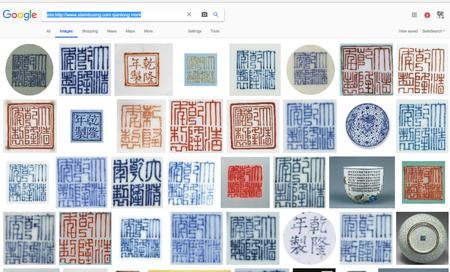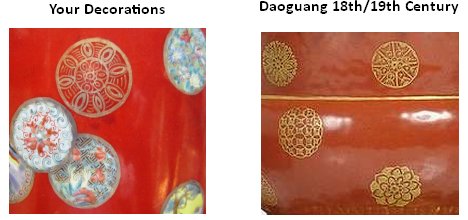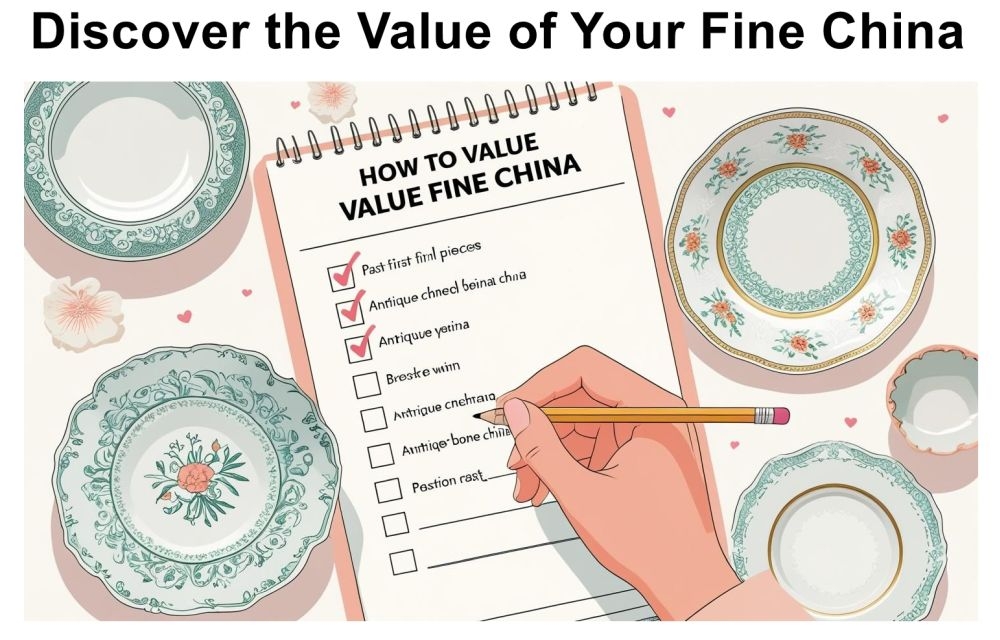Chinese Vase, Qianlong Red Seal Mark - Antique Appraisal & Research for Value & Date
by Felipe
(Spain)

antique appraisal value qianlong gourd vase
Hi Pete
Thanks for a very useful site.
I'm searching for an unusual similar pattern on my Qianlong Wax Gourd (I believe) vase but nowhere to be found...
very plain with small scenic medallions on a maroon background...
Regards,
Felipe
p.s. I am an antiques seller in my home town and do quite a bit of research online
Here are some extra close up pics:

----------------------
Peter(admin's) Evalaution and research notes:
Antique appraisal on red Chinese vase with Red Seal Square stamp mark
Chinese Haitangzun Coral Ground Medallion Vase Marked "Da Qing Qianlong Nian Zhi" which translates as "Great Qing Qianlong Period Make"
Value: Although attractive, nice quality and well produced the likelihood is that this vase is of 20th century origin and has a value in the region of $400-$600 USD. If identified by a Qianlong specialist to be of the period, it might sell for between $3000-$7000 USD.
Background: The Qing Dynasty ruled 1644-1912 within which the Emperor Qianlong reigned from 1736-1795. This vase has a mark written with some finesse and unlike many poorly stamped red seal marks on 20th century replicas cannot be written off too quickly. The medallion decoration also appears not too inconsistent with work of the period, so I suggest a second opinion or two - which I will help you to acquire - just in case you are sitting on a hidden treasure. Haitangzun is a shape of vase first known in the Yongzheng Dynasty (1723–1735 AD) and is named after its similarity in appearance with the begonia bud.
Best regards
Peter Admin
----------------------------------------
Sleuthing Points for Felipe's Red Chinese Vase
Felipe
You mentioned to me in an email, you could do with comparing notes on sleuthing...
Here goes: The sleuthing points if you were looking to go into Google overdrive yourself on this very tricky and specialist area of Chinese porcelain would be:
1. What does the mark say? You already knew this said 'Qianlong' (and Qianlong dates to the 18th Century), but for those that don't know how to read Chinese, I have a helpful section here, and also Gotheborg.com is an excellent source.
2. The mark - is this mark an obvious poorly done modern stamp? - Bearing in mind that as far as I know, rubber stamps didn't appear until the mid 19th century.
There are a few different types of look to real Qianlong marks - none of them cheap and smudgy looking to my knowledge. Some of them are hand written and a bit wobbly, but not totally mass-produced looking. Below is a comparison of your mark against some real marks of the period and a modern rubber stamp.
A great way of getting a feel for this is to put the following advanced search at Google images:
site:http://www.alaintruong.com qianlong mark
(Alain Truong is a French blogger on high art auction sales)
That search brings up this screen full of real genuine marks so you can get an instant education on what real Qianlong marks should look like:

So looking at some of these marks more closely

The downside of your mark is I don't immediately see any with an angled border edging quite like yours. The writing itself on first appearance isn't too dissimilar to that of genuine Qianlong marks.
So the answer to the second sleuthing question as to whether or not this is an obvious poorly done modern stamp is - "No".
Moving on to the next point . . .
----------------------------------------
More investigations into Felipe's Mark
So having looked at the mark, we are now moving the investigations onto the vase itself.
Here, the sleuthing questions to ask are:
Is the shape right for the period?
Is the red colour correct for the period?
Are the medallion decorations of the period?
Shape
This shape of vase is called 'Haitangzun' or begonia-shaped' vase. It has a flared rim, a flaring foot, lobed shape with a concave neck. It originated in the reign just before the Qianlong in the Yongzheng Dynasty (1723–1735).
So, again, yes this is right for the Qianlong period.
Colour
Just Googling around for red ground Chinese vases, you quickly discover this colourway is called 'coral-ground'. And with a quick bit of research you quickly see that coral ground was a technology that was around in the Qianlong period.
So, again, yes this is right for the Qianlong period.
Medallion Decoration
Are the medallion decorations of the period? I found nothing definitive on this - there isn't much info around on 'gilded medallion decoration on coral ground', just a Daoguang Dynasty 1782–1850 cache pot I saw on the Truong blog and a small vase estimated at auction to sell for around $1000 USD with a very similar blue Qianlong mark to the genuine blue seal marks shown above.
Here's a detail of the Daoguang decoration:

So no info on the polychrome medallions at all, but the gilt medallion decoration on coral ground does appear to be right for the period, although rare.
Let's make some conclusions, but not before we get a second opinion or two . . .
----------------------------------------
Reaching my conclusion based on the evidence
So here are the things we have found out within this most tricky area of Chinese Qianlong porcelain (where a woman recently found an old vase on her deceased sister's shelf that sold for $50 Million) - just by doing a bit of sleuthing, that anyone can do themselves without yet consulting a specialist in Qianlong.
So the colour, decoration and mark all appear to be possibly from the period. At least, we can't laugh them away immediately as ridiculous modern tat. So, at least, this is a well made reproduction trying to emulate high qualities.
But is it from the Qianlong period, thus making it worth four figure sums?
The biggest consideration in this is the overwhelming likelihood that this is much more modern than 18th century (Qianlong) - a nicely made export item in the Republic Period (1911-1949). Just in terms of numbers, real Qianlong items are rare, more modern replicas are commonplace.
So just to confirm, go to Liveauctioneers.com, find some boutique auctioneers who specialise in getting high prices for Qianlong ware and send them photos.
(note: Felipe did this and three separate auctioneers said this was more modern and not Qianlong in their opinion).
If you wanted to quadruple check, as there is a lot of money at stake, Christies and Sothebys would be the place to go.
Best regards
Peter (admin)
Comments for Chinese Vase, Qianlong Red Seal Mark - Antique Appraisal & Research for Value & Date
|
||
|
||

Inherited a china set?... Download my free 7-point checklist to instantly assess its potential value.
From the Studio
• Peter Holland Posters
• Sculpture Studio







